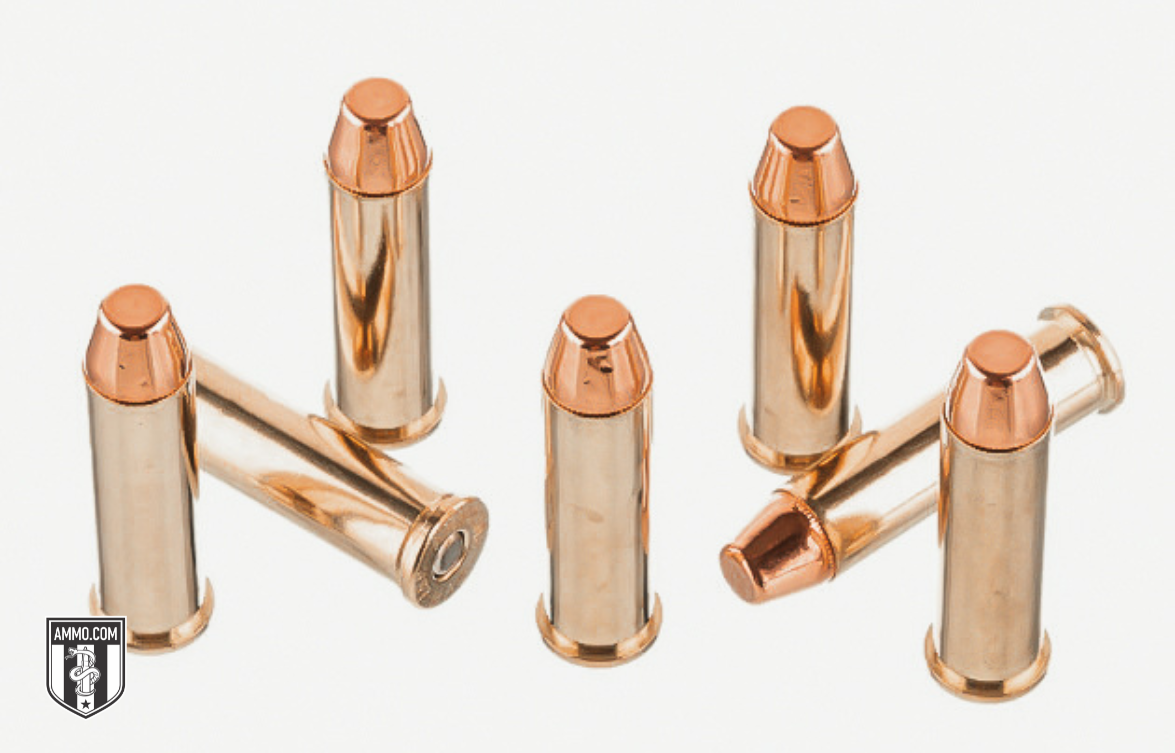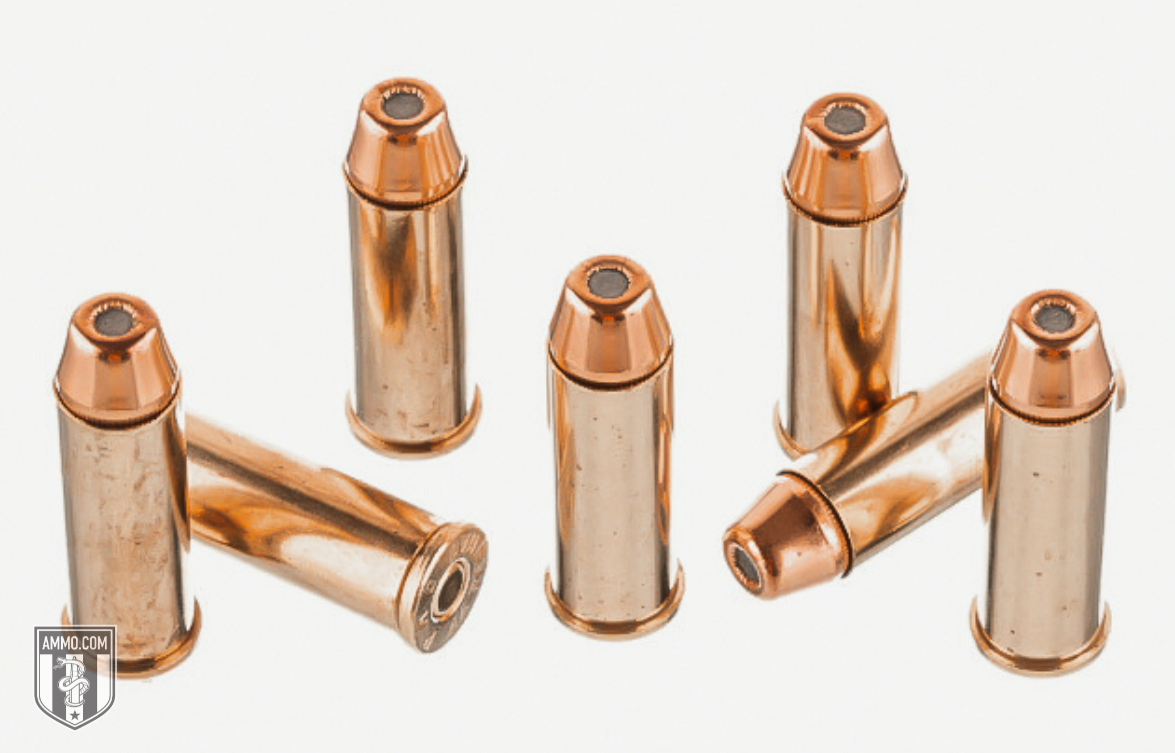460 S&W vs. 44 Mag: Which Is the Better Heavy Hitting Handgun Cartridge?
The 460 Smith & Wesson Magnum and 44 Remington Magnum are both powerful handgun cartridges – but which is better for target shooting, self-defense, and hunting?
In this 460 S&W vs. 44 Mag comparison, let’s pit these two magnum handgun cartridges against one another in real-world situations, such as the amount of recoil, stopping power, and overall cost, to help you determine which is better for your situation.
Differences Between 460 S&W & 44 Mag
Though they’re both magnum cartridges often chambered in revolvers, it doesn’t mean they are identical. In fact, we’ll soon see the drastic differences in cartridge specifications and how those differences determine how each performs in various shooting scenarios.
Cartridge Specs
The legendary Elmer Keith created the 44 Magnum many decades ago based on the 44 S&W Special; it features a 0.429” diameter bullet, 0.457” case neck and base diameter, and 1.285” long case with 37.9 grains H2O capacity.
The 460 S&W was created just a couple of decades ago based on the 454 Casull; it features a 0.452” diameter bullet, 0.478” case neck and base diameter, and 1.8” long case (the 460 S&W’s case alone is 0.19” longer than the entire 44 Mag cartridge, the latter of which has an overall length of 1.61”). The 460 S&W’s overall length is 2.3”. Its case capacity is 60 grains H2O.
The disparity between the two rounds’ maximum chamber pressures is immense. The 44 Mag is no pantywaist at 36,000 psi – but at 65,000 psi, the 44 S&W is 1986 Mike Tyson.
Now, let’s see how these differences affect real-world performance, beginning with recoil.
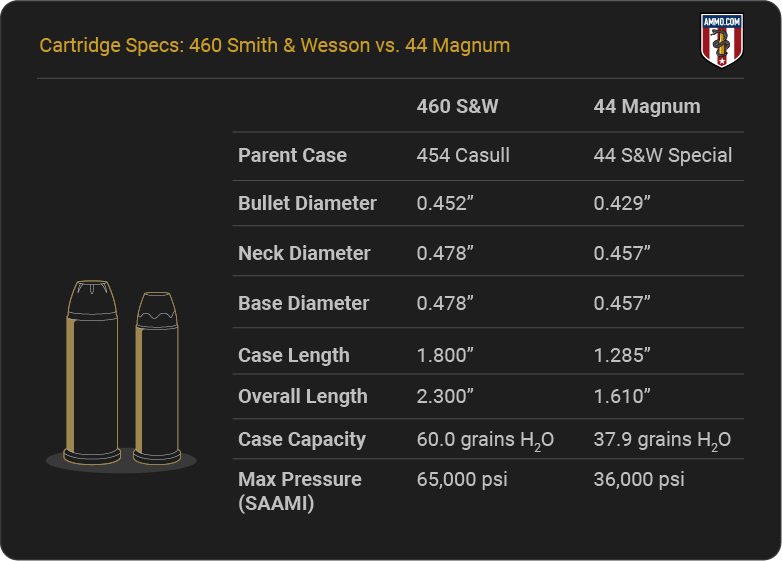
Recoil: 460 Smith & Wesson Magnum vs. 44 Remington Magnum
When comparing two cartridges, it’s prudent to begin with their recoil. The round that kicks harder will cause sharper muzzle flip, which can lead to less accurate follow-up shots as a result. Strong kick can also worsen accuracy by causing the shooter to flinch (i.e., reflexively jerk their firearm off target in anticipation of recoil).
Neither of these rounds is known for its lack of recoil. Dirty Harry wouldn’t still be considered the pinnacle of cool if his preferred revolver were weak, and the 460 S&W is way more powerful than the 44 Mag. But how do these rounds’ recoil compare, objectively?
We won’t consider how much recoil shooters typically feel while firing these rounds. Such experiences are subjective: just as immeasurable as they are incomparable. Rather than felt recoil, let us focus on “free recoil.” It is the product of exactly four variables: projectile weight, propellant weight, muzzle velocity, and firearm weight.
When a 260 grain 460 S&W bullet achieves 1,590 fps muzzle velocity from a 4.5-pound firearm, free recoil equals 20 ft-lbs of energy. However, when firing a 250 grain bullet at 1,400 fps from the same firearm, recoil energy drops to 12.8 ft-lbs.
When a 240 grain 44 Mag bullet achieves 1,200 fps muzzle velocity from a 3.5-pound revolver, recoil equals 18.5 ft-lbs. Recoil varies a great deal depending on the aforementioned factors. Bearing that in mind, the 460 S&W typically generates more recoil than the 44 Mag, even when fired from a heavier firearm.
The 44 Mag, therefore, wins this section.
Trajectory
A bullet’s trajectory quantifies its flight path as it travels downrange. It is often measured in inches of bullet drop. When it traces the path from the muzzle to a close-range target, a trajectory resembles a flat line. At long range, a trajectory resembles an arch, as the bullet must rise and fall as it accommodates the unrelenting effect of gravity.
The flatter a cartridge’s trajectory, the easier long-range shooting becomes. A flatter trajectory requires the shooter to make fewer adjustments to their aim – primarily by making less compensation for bullet drop.
Different cartridges have different trajectories. While there are exceptions to the rule, the 460 S&W typically produces the flatter trajectory. If sighted in at 25 yards, a 360 grain 460 S&W bullet with 1,600 fps muzzle velocity will drop only -3.66” at 100 yards. Under the same circumstances, a 180 grain 44 Mag bullet with 1,500 fps muzzle velocity will drop -5.3”.
Neither cartridge is intended for long-range shooting. Even so, we can’t deny the 460 S&W’s victory in this section.
Accuracy: 44 Mag vs. 460 S&W
Several factors affect a cartridge’s accuracy, including the firearm, the person operating said firearm, and the atmospheric conditions said person operating said firearm within. All of this is to say that it would be frivolous to declare one cartridge “more accurate” than any other.
However, we can assume that recoil-sensitive shooters will be more accurate with the 44 Mag out to 125 yards. The 460 S&W will be more accurate in shooters' hands, looking to push magnum effective range (within 200 yards).
This section is a tie, as it will depend on your shooting ability.
Stopping Power
“Stopping power” means different things to different shooters. We could argue about the exact definition, but for the sake of time, let’s agree that penetration depth, wound column diameter, and kinetic energy transfer are the primary determinants of stopping power. We’ll also acknowledge the importance of shot placement: a well-placed shot from a weak cartridge will prove more effective than a poorly placed shot from a powerful one.
Keeping all that in mind, the 460 S&W has a clear energy advantage over the 44 Mag because it fires larger projectiles that conserve higher momentum downrange and strike considerably harder as a result. The 360 S&W’s wider bullet is also inclined to inflict the same kind of wound channel (namely, a wider one).
At 50 yards, a 360 grain LFN 460 S&W bullet achieving 1,600 fps out of the muzzle maintains 1,714 ft-lbs of energy. At that same distance, a 340 grain LFN 44 Mag bullet achieving 1,400 fps out of the muzzle maintains 1,294 ft-lbs of energy.
The 460 S&W wins this section. Once again, the 44 Mag is no slouch. Many consider it too powerful for personal protection against conventional human threats. But the 460 S&W is just on another level – so much so that 460 ammo for defense against humans is virtually nonexistent.
Hunting: 460 S&W Mag vs. 44 Rem Mag
The 460 S&W and 44 Mag may not compete with the hand cannon 500 S&W Magnum regarding dangerous game hunting, although they’re still solid options. These big-bore cartridges outshine the 357 Magnum and 45 ACP for carbine and handgun hunting.
The 460 Smith and Wesson Magnum’s greater stopping power makes it the better option for harvesting big game animals like bear, elk, and moose. The 44 Mag is a better option for whitetail deer and medium game because it’s less powerful and won’t damage meat as severely.
This section is a tie. Both cartridges excel at harvesting the game they were designed for.
Defense
Both of these rounds are great for bear defense, but I would not recommend either for concealed carry or home defense.
For starters, both require large and unwieldy revolvers. The 357 Mag, 45 Automatic Colt Pistol, 9mm, and even the 38 Special are all better options for concealed carry because they won’t force you to lug around a hand cannon like the Smith & Wesson X-Frame 460 XVR or Magnum Research Desert Eagle.
Not only do they require magnum revolvers and carbines, but these massive rounds are also much more likely to penetrate the threat and multiple walls behind them, thus potentially endangering innocent bystanders. Maybe it’s because I’m not the world’s greatest shot, but I want more than five or six rounds in my home defense firearm. I’d also rather not have to overcome strong recoil while I’m trying to pour lead into a threat, and the thought of listening to either round’s report indoors and without hearing protection doesn’t thrill me.
If forced to choose, I’d prefer the 460 S&W for bear defense and the 44 Mag for home defense. I’ll still call this section a tie, as neither round is a great pick for conventional defensive scenarios.
Cost & Availability: 44 Magnum vs. 460 Smith & Wesson
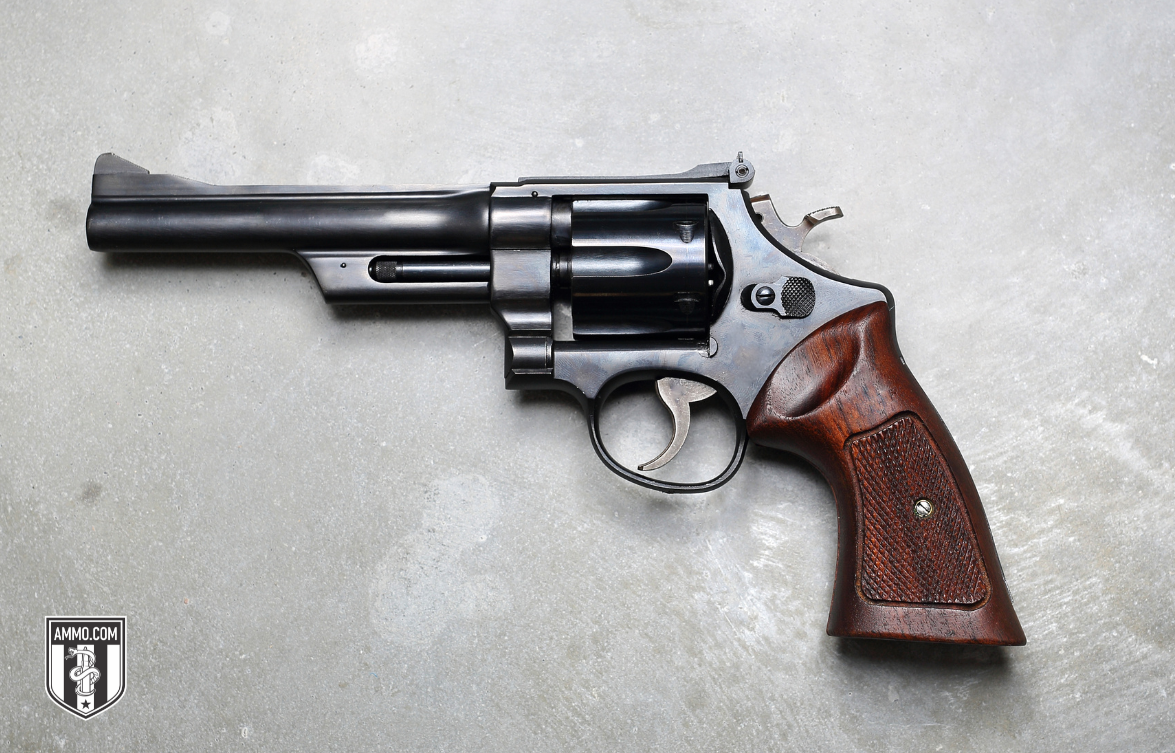
The 44 Magnum takes the cake regarding overall cost and availability, but it’s by no means inexpensive. Neither cartridge is great for a day of inexpensive plinking at the range.
At the time of writing, 44 Mag firearms range in price from $600 to $2,000. Most cost around $1,000, such as the Ruger Super Blackhawk, Super Redhawk, and S&W Model 69. The Marlin Model 1894 lever-action rifle costs $1,200.
As of this writing, most 460 S&W Mag revolvers range in price from $1,000 to $2,000. For example, the Magnum Research BFR costs around $1,400; the Smith & Wesson Model 460XVR, around $1,700.
Factory ammo is much the same; 44 Mag factory loads cost about $1.45/round for the cheap stuff (hard cast bullets) and $3.50 per round.
460 S&W ammo costs about $2.30/round for Hornady Custom FTX handgun loads and $4.50/round for Buffalo BORE Personal Defense. In addition to requiring more materials to manufacture, the 460 S&W's higher price tag is due to its relative unpopularity—fewer companies produce it!
The 44 Magnum’s lower cost per round and wider selection of firearms win this section.
Reloadability
Reloading spent casings is an excellent way to save money on factory ammo. You can optimize your firearm’s performance by carefully crafting the ideal handloads for it, too. The significant upfront cost of tools and equipment dissuades many from picking up handloading as a hobby, but no high-volume shooter should go without it.
Both cartridges are reloadable, with plenty of load data and supplies available. This section is a tie.
Ballistics
All the numbers nerds will love this section, where we dive into the ballistic performance of each cartridge. The tables below will help you quickly compare either round’s muzzle velocity, muzzle energy, and trajectory.
460 S&W Ballistics
Note: This information comes from the manufacturer. The actual ballistics obtained with your firearm can vary considerably from advertised ballistics. Ballistics can also vary from lot to lot within the same brand and load type.
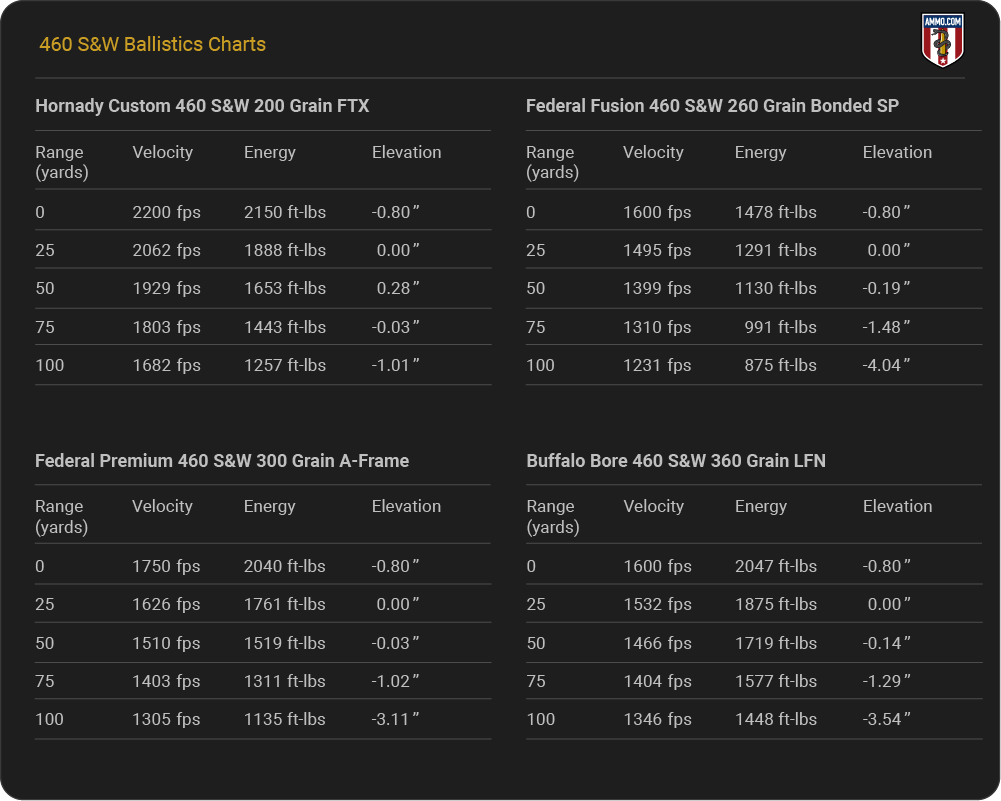
44 Mag Ballistics
Note: This information comes from the manufacturer. The actual ballistics obtained with your firearm can vary considerably from advertised ballistics. Ballistics can also vary from lot to lot within the same brand and load type.
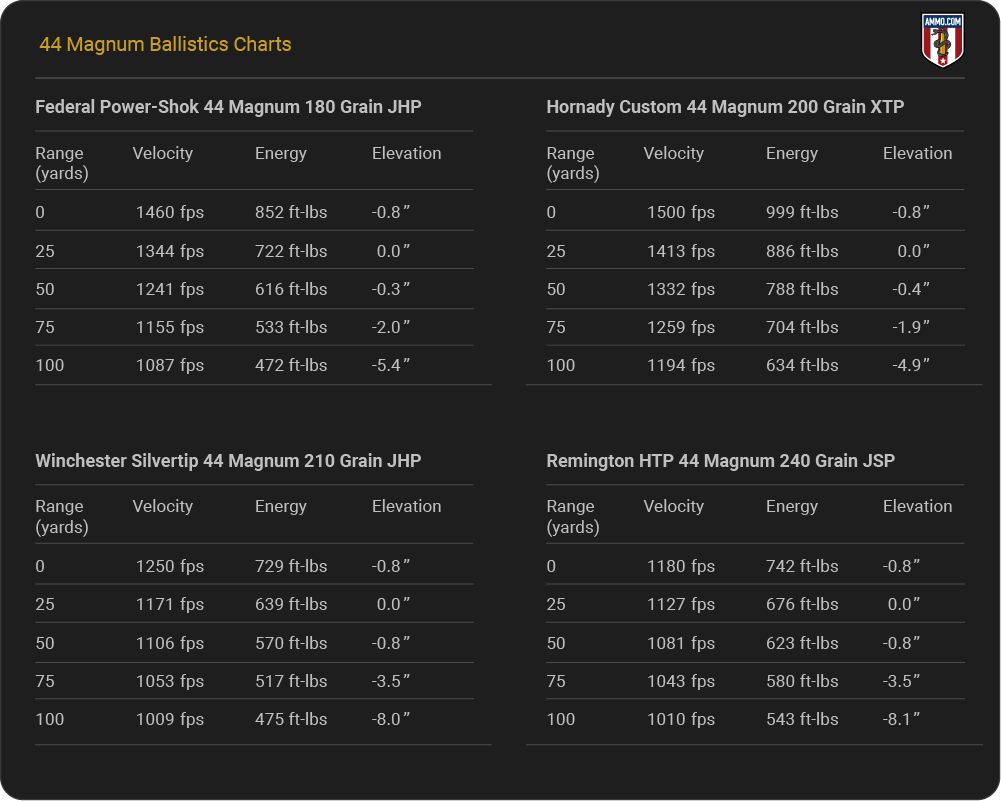
Take a deep dive into our 44 Magnum ballistics tables for factory ammo.
460 S&W Brief History
Hornady and Smith & Wesson teamed up to develop the 460 Smith & Wesson Magnum. It was released in 2005. Since it was designed using the 454 Casull, firearms chambered in 460 S&W can often safely fire 454 Casull, 45 Colt, and 45 Schofield ammo (but not vice versa).
Smith & Wesson has boasted that the 460 S&W is the highest-velocity revolver cartridge in the world, but the more recently introduced 500 Bushwhacker makes that claim easily debatable.
While the 460 S&W has not been a raging commercial success, it has proven itself a viable option for handgun hunting over the past couple of decades. A few long guns are also chambered in 460 S&W, including the Big Horn Armory Model 90 lever-action rifle, Ruger No.1 single-shot rifle, and Thompson Center Encore Pro Hunter single-shot rifle.
44 Mag Brief History
Elmer Keith developed the .44 Magnum cartridge for handgun hunting. He made high-pressure loads that pushed a heavy bullet faster than ammunition of this bullet size. He worked with Smith & Wesson and Remington to bring the Model 29 and its ammo to market.
Since its commercial production began in 1956, the 44 Mag has proven itself a viable handgun hunting round and remains the go-to choice for many hunters entering bear country. I enjoy sending a few 44 Mag bullets downrange using my Desert Eagle, so I see why it’s remained so popular for so many decades and believe it will continue to be a top choice.
Parting Shots
Now that you’ve finished reading this 460 S&W vs. 44 Mag comparison, you know that the 460 S&W won two sections (trajectory and stopping power). Four sections were tied (accuracy, defense, hunting, and reloadability). The 44 Magnum won two sections (recoil and overall cost).
Both cartridges excel in specific situations. The 460 S&W should be the top choice for long-range handgun hunters. In contrast, close-range hunters will find the 44 Mag more than sufficient.
Remember: You can fulfill all your ammo needs at Ammo.com, regardless of which cartridge you choose!
Frequently Asked Questions
Below, the team at Ammo.com has gathered and answered some of the most commonly asked questions regarding the 460 S&W vs. 44 Mag.
Which Has More Stopping Power: 460 S&W or 44 Magnum?
The .460 S&W has more stopping power.
Can The 460 S&W Magnum Be Used For Big Game Hunting?
Yes, the 460 S&W can be used for big game hunting.
What Is The Effective Range Of A 460 S&W Compared To A 44 Magnum?
The effective range of a 460 S&W is generally about 200 yards, whereas the effective range of the 44 Magnum is typically 125 yards.
Ammo Comparisons
- .308 vs 5.56
- 6.5 Creedmoor vs .308
- .300 Blackout vs .308
- .300 Win Mag vs .308
- .243 vs .308
- .308 vs .30-06
- 7mm-08 vs .308
- .270 vs .308
- 7.62x39 vs .308
- .223 vs .308
- .338 Lapua vs .308
- .380 ACP vs 9mm
- .223 vs 5.56
- .300 Blackout vs 5.56
- 9mm vs 45 ACP
- 9mm vs 40 S&W
- .357 SIG vs 9mm
- 10mm vs 9mm
- 9mm vs 9mm Luger
- .243 vs .270
- .300 Win Mag vs .30-06
- .270 vs .30-06
- .40 vs .45
- 38 Special vs 357
- 9mm vs 40 vs 45
- 5.56 vs 7.62x39
- 338 Lapua vs .30-06
- .30-30 vs .30-06
- 300 PRC vs 338 Lapua
- .30-06 vs 7mm
- 300 Win Mag vs 338 Lapua
- 300 PRC vs 300 Win Mag
- 300 WSM vs 300 Win Mag
- 338 Win Mag vs 338 Lapua
- 12 Gauge vs 20 Gauge
- 10mm vs 357 Mag
- .30-30 vs 7.62x39
- 224 Valkyrie vs 22-250
- 17 HMR vs 22 Mag
- 7.62x39 vs .300 Blackout
- 45 ACP vs 45 Auto
- 45-70 vs 30-30
- 300 Blackout vs 223
- 357 Magnum vs 9mm
- 350 Legend vs 300 Blackout
- 224 Valkyrie vs 223
- 45 ACP vs 38 Super
- 6.5 Grendel vs .308
- 17 HMR vs 22 LR
- 10 Gauge vs 12 Gauge
- 22-250 vs 223
- 45 Colt vs 45 ACP
- 350 Legend vs 30-30
- 5.7x28 vs 223
- 5.7 vs 9mm
- 5.56 vs 5.7
- 22 vs 9mm
- Buckshot vs Birdshot
- 450 Bushmaster vs 308
- 450 Bushmaster vs 223
- Buckshot vs Slug
- 6.5 Grendel vs 5.56 vs 223
- 6mm ARC vs 6.5 Grendel
- 44 vs 45
- 458 SOCOM vs 5.56
- 357 vs 44
- 32 ACP vs 380
- 300 Win Mag vs 338 Win Mag vs 338 Lapua Mag
- 450 Bushmaster vs 458 SOCOM vs 50 Beowulf
- 6mm Creedmoor vs 6.5 Creedmoor
- TMJ vs FMJ
- 44 Special Vs 44 Magnum
- 45 90 vs 45 70
- 6.8 Western vs 6.8 SPC
- 50 Beowulf vs 50 BMG
- 26 Nosler vs 6.5 PRC
- 28 Gauge vs 410
- 6.8 SPC vs 5.56
- 6.8 SPC vs 6.5 Grendel
- 6.8 Western vs 7mm Rem Mag vs .28 Nosler
- 6.8 Western vs 6.5 Creedmoor
- 22 Hornet vs 223
- 6.8 Western vs 6.5 PRC
- .410 vs 12 Gauge
- .410 vs 20 Gauge
- 22 LR vs 22 Mag
- 6mm ARC vs 243
- 7mm-08 vs 270
- 243 vs 6.5 Creedmoor
- Nickel vs Brass Casing
- 204 Ruger vs 223
- 50 Beowulf vs 5.56
- 260 Remington vs 6.5 Creedmoor
- 6mm Remington vs 243
- 28 Nosler vs 300 PRC
- 50 Beowulf vs 50 AE
- 22 Nosler vs 22-250
- 450 Marlin vs 45-70
- 300 Win Mag vs 300 Norma
- 458 SOCOM vs 300 Blackout
- 38-55 vs 45-70
- 22 Hornet vs 22 LR
- 300 Norma vs 338 Lapua
- 338 Lapua vs 50 BMG
- 28 Nosler vs 300 Win Mag
- 28 Nosler vs 6.5 Creedmoor
- 204 vs 22-250
- 458 SOCOM vs 45 70
- 44 40 vs 45 70
- 6.8 SPC vs 6.5 Creedmoor
- 450 Bushmaster vs 30-06
- 7mm Rem Mag vs 300 Win Mag
- 30 Carbine vs 223
- 25-06 vs 30-06
- 26 Nosler vs 28 Nosler
- 16ga vs 12ga
- 30 06 vs 7.62 x54R
- 9mm Makarov vs 9mm Luger
- 350 Legend vs 223
- 30 Carbine vs 5.56
- 6.5x55 vs 6.5 Creedmoor
- 6.5 Creedmoor vs 270 vs 25-06
- M193 vs M855
- 450 Bushmaster vs 458 SOCOM
- 6.5 Grendel vs 6.5 Creedmoor
- 350 Legend vs 5.56
- .277 Fury vs 6.8 SPC
- 277 Fury vs 300 Win Mag
- 10mm vs .45 ACP
- 277 Fury vs 223
- 6.8 SPC vs 300 Blackout
- 6.5 PRC vs 6.5 Creedmoor
- 277 Fury vs 308
- 277 Fury vs 6.5 Creedmoor
- 350 Legend vs 450 Bushmaster
- 277 Fury Vs 5.56 NATO
- 10mm vs 40S&W
- 32 ACP vs 9mm
- 32 Special vs 9mm
- 8.6 Blackout vs 300 Blackout
- 30 Super Carry vs. 9mm
- 5.56 vs 9mm
- .50 Action Express vs 9mm
- 7.62x25 vs. 9mm
- 10mm vs 44 Magnum
- 300 Blackout vs 300 Win Mag
- 6.5 Grendel vs 300 Blackout
- 460 Rowland vs 10mm
- 300 RUM vs 300 PRC
- 300 Norma vs 300 PRC
- 45 GAP vs 45 ACP
- 7mm PRC vs 300 Win Mag
- 300 PRC vs 6.5 Creedmoor
- 300 PRC vs 308
- 357 SIG vs 357 Mag
- 7.62x39 vs 7.62x51
- 243 Win vs 223 Rem
- 30 Nosler vs 300 PRC
- 6.5 Creedmoor vs. 30-06 Springfield
- 450 S&W vs. 44 Magnum
- 6.5 Creedmoor vs. 300 Win Mag
- 454 Cassull vs. 45-70 Govt
- 454 Cassull vs. 44 Mag
- 7.62x54r vs. 308 Winchester
- 22 ARC vs. 223 Rem
- Subsonic vs. Supersonic Ammo
